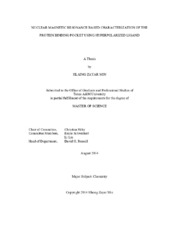| dc.description.abstract | In the drug design process, the structural determination of the protein-ligand binding interface and understanding how the drug binds to the target protein at the protein binding pocket is essential. In the past few years, Dynamic Nuclear Polarization (DNP) combined with Nuclear Magnetic Resonance (NMR) has emerged as a new tool for studying interactions between different molecules. In this study, the DNP-NMR technique was employed for characterization of the protein binding pocket through binding of the hyperpolarized ligand to the protein. Trypsin and benzamidine were chosen as models for the protein and the ligand because the binding of benzamidine to trypsin is well-known.
Several enhanced NMR signals of trypsin appeared from the binding of hyperpolarized benzamidine to trypsin. A significant finding was that those trypsin signals were non-uniformly enhanced when compared with the trypsin signals in the conventional (non-hyperpolarized) NMR spectrum, suggesting that a specific region of the protein, most likely the protein-binding pocket proximal to the bound hyperpolarized ligand, is selectively polarized. The polarization transfer process was described mathematically by fitting model equations to the enhanced signal intensities of both the protein and the ligand. A fit parameter was evaluated, which assuming the presence of a single spin on protein and ligand can be interpreted as a cross-relaxation rate (σ_(DNP)), that can provide spatial information between the two spins.
Saturation Transfer Difference (STD)-NMR was employed as an independent method to measure the protein-ligand interaction. The fit parameters in the STD-NMR equations, the dissociation constant (K_(D)) and a cross-relaxation rate (σ_(STD)), were evaluated. KD determined from STD-NMR was consistent with the K_(D) values reported in the literatures, suggesting that STD-NMR data is reliable. σ_(STD) evaluated from STD-NMR was compared with σ_(DNP) evaluated from the DNP-NMR and found to be similar in magnitude. | en |


